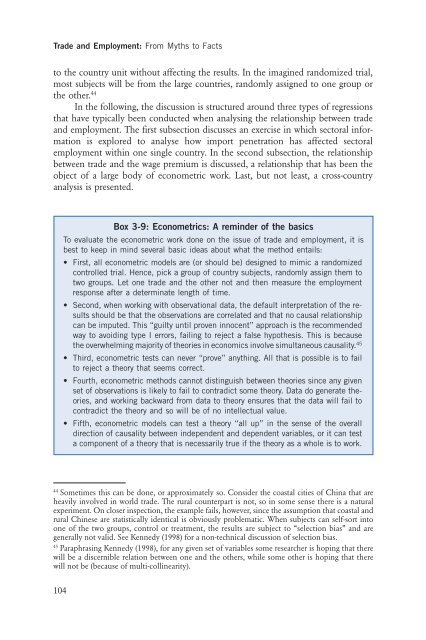Trade and Employment From Myths to Facts - International Labour ...
Trade and Employment From Myths to Facts - International Labour ...
Trade and Employment From Myths to Facts - International Labour ...
You also want an ePaper? Increase the reach of your titles
YUMPU automatically turns print PDFs into web optimized ePapers that Google loves.
<strong>Trade</strong> <strong>and</strong> <strong>Employment</strong>: <strong>From</strong> <strong>Myths</strong> <strong>to</strong> <strong>Facts</strong><br />
<strong>to</strong> the country unit without affecting the results. In the imagined r<strong>and</strong>omized trial,<br />
most subjects will be from the large countries, r<strong>and</strong>omly assigned <strong>to</strong> one group or<br />
the other. 44<br />
In the following, the discussion is structured around three types of regressions<br />
that have typically been conducted when analysing the relationship between trade<br />
<strong>and</strong> employment. The first subsection discusses an exercise in which sec<strong>to</strong>ral information<br />
is explored <strong>to</strong> analyse how import penetration has affected sec<strong>to</strong>ral<br />
employment within one single country. In the second subsection, the relationship<br />
between trade <strong>and</strong> the wage premium is discussed, a relationship that has been the<br />
object of a large body of econometric work. Last, but not least, a cross-country<br />
analysis is presented.<br />
Box 3-9: Econometrics: A reminder of the basics<br />
To evaluate the econometric work done on the issue of trade <strong>and</strong> employment, it is<br />
best <strong>to</strong> keep in mind several basic ideas about what the method entails:<br />
• First, all econometric models are (or should be) designed <strong>to</strong> mimic a r<strong>and</strong>omized<br />
controlled trial. Hence, pick a group of country subjects, r<strong>and</strong>omly assign them <strong>to</strong><br />
two groups. Let one trade <strong>and</strong> the other not <strong>and</strong> then measure the employment<br />
response after a determinate length of time.<br />
• Second, when working with observational data, the default interpretation of the results<br />
should be that the observations are correlated <strong>and</strong> that no causal relationship<br />
can be imputed. This “guilty until proven innocent” approach is the recommended<br />
way <strong>to</strong> avoiding type I errors, failing <strong>to</strong> reject a false hypothesis. This is because<br />
the overwhelming majority of theories in economics involve simultaneous causality. 45<br />
• Third, econometric tests can never “prove” anything. All that is possible is <strong>to</strong> fail<br />
<strong>to</strong> reject a theory that seems correct.<br />
• Fourth, econometric methods cannot distinguish between theories since any given<br />
set of observations is likely <strong>to</strong> fail <strong>to</strong> contradict some theory. Data do generate theories,<br />
<strong>and</strong> working backward from data <strong>to</strong> theory ensures that the data will fail <strong>to</strong><br />
contradict the theory <strong>and</strong> so will be of no intellectual value.<br />
• Fifth, econometric models can test a theory “all up” in the sense of the overall<br />
direction of causality between independent <strong>and</strong> dependent variables, or it can test<br />
a component of a theory that is necessarily true if the theory as a whole is <strong>to</strong> work.<br />
44 Sometimes this can be done, or approximately so. Consider the coastal cities of China that are<br />
heavily involved in world trade. The rural counterpart is not, so in some sense there is a natural<br />
experiment. On closer inspection, the example fails, however, since the assumption that coastal <strong>and</strong><br />
rural Chinese are statistically identical is obviously problematic. When subjects can self-sort in<strong>to</strong><br />
one of the two groups, control or treatment, the results are subject <strong>to</strong> “selection bias” <strong>and</strong> are<br />
generally not valid. See Kennedy (1998) for a non-technical discussion of selection bias.<br />
45 Paraphrasing Kennedy (1998), for any given set of variables some researcher is hoping that there<br />
will be a discernible relation between one <strong>and</strong> the others, while some other is hoping that there<br />
will not be (because of multi-collinearity).<br />
104

















